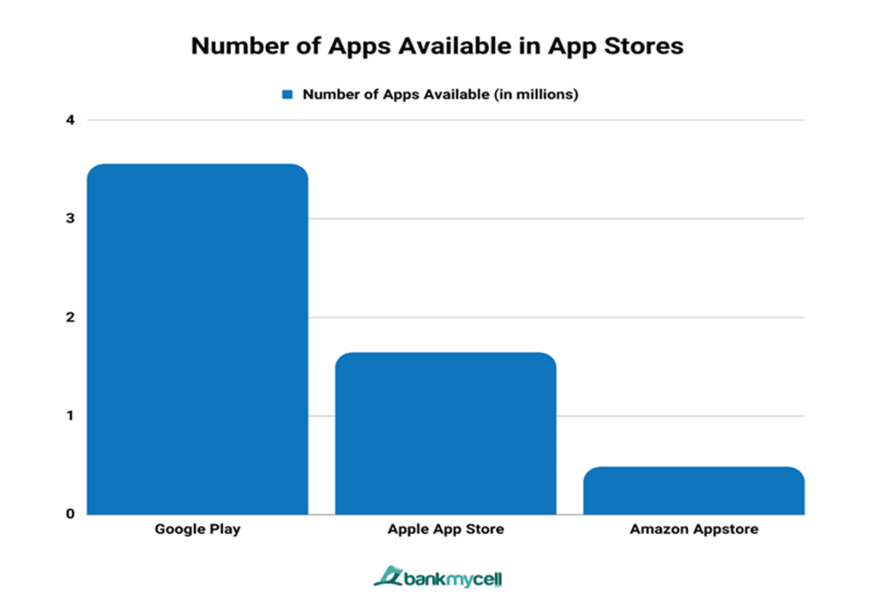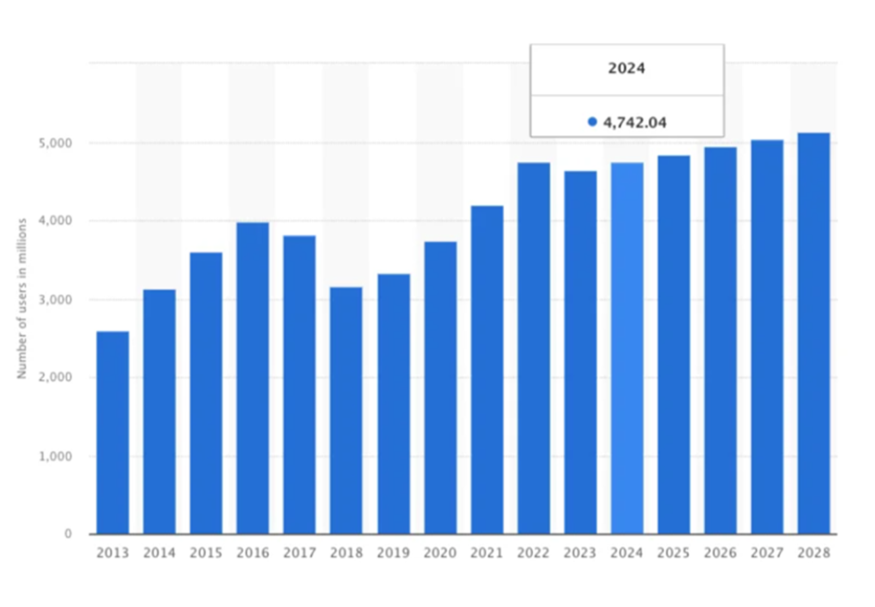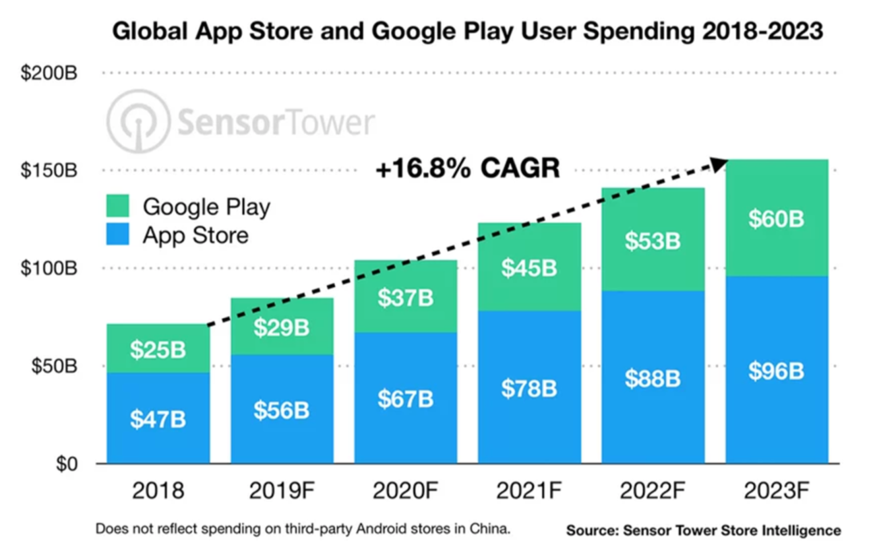Abstract: This article describes the role of cloud computing in accelerating the development and scaling of digital products for mobile devices. It provides a detailed analysis of the benefits of integration and the prospects of transitioning to cloud services in mobile development when launching new applications.
Keywords: mobile applications, cloud technologies, development, integration, performance.
Mobile applications account for 85% of the total time users spend on smartphones. Digital products for such devices have quickly become an integral part of daily life for many people. Often, they play a key role in shopping, banking, entertainment, and work. Today, there are approximately 9 million smartphone applications in total. In the largest app stores, Google Play Store and Apple App Store, their numbers are around 3.5 million and 1.6 million, respectively. It is expected that in 2025, revenue from usage and advertising in these products will exceed $613 billion.

The significant growth in the number of applications has been driven by the revolutionary approach of cloud computing, which accelerates development, deployment, and scaling of digital products. Clouds provide developers and businesses access to computing power and data storage without the need to own physical servers and incur maintenance costs. These technologies offer easy access to resources anywhere in the world, at any time, while eliminating the need to manage complex communication and computing devices. According to the latest forecasts, the global cloud services market is expected to reach $927.5 billion by 2027, with a compound annual growth rate of 16.4%. This significant growth is driven by high demand for innovative solutions that accelerate digital transformation.
Key Benefits of Integrating Cloud Computing with Mobile Application Development
Integrating cloud services into smartphones offers numerous benefits for both developers and end-users. Leveraging the potential of the cloud enables businesses to create innovative and multifunctional products that ensure smooth operation and a positive user experience.
The advantages of implementing cloud technology in smartphone applications are evident:
- Increased performance — allows shifting computing power and storage to remote servers, enhancing performance and responsiveness;
- Real-time updates — cloud services enable developers to keep digital products up-to-date through continuous updates and integration of the latest improvements;
- Independent access — allows smartphone owners to store data locally and synchronize with the cloud when a network connection is available, ensuring uninterrupted access to content, including offline.
Thanks to cloud technologies, users can significantly reduce the load on their smartphones, freeing up resources such as processing power and memory. This is particularly valuable for low-performance devices, which would otherwise struggle with resource-intensive applications.
Cloud computing allows smooth scalability as consumer demand and business requirements grow. Such infrastructure can handle high server loads and adapt to client activity without affecting the efficiency and convenience of mobile usage. This advantage enables companies to avoid unexpected downtime and maintain stable customer interactions even during peak demand periods.
Application or data storage updates are delivered through the cloud infrastructure. They do not require users to manually download or install them on their devices — the process happens automatically. This ensures that clients always have access to the latest version of digital products and the most up-to-date data.
Cloud technologies open new horizons in security and efficiency. Storing data on remote servers protects confidential information in case of smartphone theft or loss. Cloud service providers invest heavily in advanced security measures, offering protection levels that most companies cannot achieve independently. Clouds also optimize collaboration, allowing multiple users to work on documents and resources simultaneously. Leveraging cloud technologies, developers create digital products that seamlessly operate across various platforms, such as Android and iOS. This allows programs to be transferred between devices and operating systems without large-scale code rewriting or interface changes. As a result, companies can reach a wider audience and significantly simplify product maintenance.
The advantages of integrating clouds into mobile applications cannot be overstated. Experts expect the number of smartphone users to reach 4.7 billion by the end of 2024.

Cloud technologies have solved many challenges in smartphone application development, simplifying development and ensuring more efficient software performance. This allows developers to adapt faster to changing user needs and maintain high application performance.
Prospects for Cloud Technology Development to Improve Mobile Application Development and Deployment
Smartphone applications are becoming increasingly advanced, and cloud integration will play a key role in their future. With growing demand for high-performance products with large volumes of data, developers need to leverage cloud technologies to achieve maximum efficiency and scalability. As the mobile application market develops, cloud synchronization will become a decisive factor for developers seeking to stay ahead of competitors and offer users the most advanced solutions. It is expected that as technology evolves, cloud systems will inevitably expand, offering increasing opportunities for use.
The future of cloud computing for mobile development is shaped by several key trends and advancements:
- Improved Network Infrastructure: The widespread adoption of 5G and the enhancement of existing networks will significantly improve reliability and ensure high performance of mobile applications;
- Edge Computing: Synchronization with the cloud will allow data processing closer to the source device, reducing latency and increasing responsiveness of real-time applications;
- Internet of Things (IoT) and Artificial Intelligence (AI): The popularity of IoT and AI will open new integration opportunities in diverse digital products, improving user experience and offering innovative use cases;
- Advances in Cloud Technology: Development of cloud technologies will lead to more advanced features, increased performance, and strengthened security of platforms and infrastructure.
Consumer spending on mobile services will continue to grow and may exceed $270 billion by 2025. According to Sensor Tower Store Intelligence, global spending on mobile digital products in the Apple App Store and Google Play is expected to increase rapidly in the coming years.

This trend confirms the steady growth of interest in smartphone applications and the rising demand for them. Cloud computing is becoming a powerful tool for developers, opening new possibilities for solving diverse challenges. Leveraging cloud technologies and staying up-to-date with the latest developments allows companies to create highly responsive, scalable, and secure digital programs that meet the needs of modern users.
Combining growing demand for mobile applications with cloud computing capabilities opens broad prospects for businesses to create innovative and competitive products that effectively meet the expectations of today's audience.
Sources:
Number of apps available in leading app stores as of 3rd quarter 2022, Dec 8, 2023, www.statista.com, (https://www.statista.com/statistics/276623/number-of-apps-available-in-leading-app-stores/)
Ultimate Mobile App Stores List (2024), 2024, buildfire.com, (https://buildfire.com/mobile-app-stores-list/)
Mobile App Usage and Growth Statistics for 2024, January 4, 2024, www.mindinventory.com, (https://www.mindinventory.com/blog/mobile-app-usage-growth-statistics/)
Mobile App Industry 2024: Trends And Statistics, 2024, ideausher.com, (https://ideausher.com/blog/mobile-app-industry-trends-and-statistics/)
© 2025 ScienceTimes.com All rights reserved. Do not reproduce without permission. The window to the world of Science Times.











